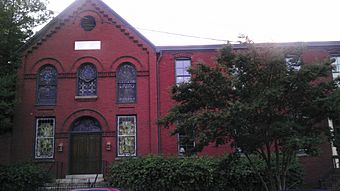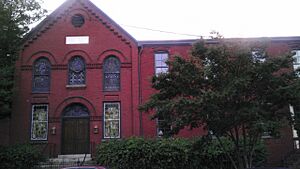Richmond Hill (Richmond, Virginia) facts for kids
Quick facts for kids |
|
|
Richmond Hill
|
|
|
U.S. Historic district
Contributing property |
|
 |
|
| Location | 2209 East Grace Street, Richmond, Virginia, U.S. |
|---|---|
| Built | 1859 |
| Architectural style | Chateauesque |
| Part of | St. John's Church Historic District (ID90002097, as increased in 1991) |
Richmond Hill is a special place in Richmond, Virginia. It's a community and a quiet retreat center where people from different Christian faiths come together. This historic building used to be a Catholic convent and school. Today, it still helps people with their spiritual and educational needs. It's part of the St. John's Church Historic District, which has many old churches.
Contents
History of Richmond Hill
How Richmond Got Its Name
Back in 1737, an explorer named William Byrd II stood on one of Richmond's highest hills. He looked out over the James River and saw a view that reminded him of his home, Richmond-on-Thames in England. That's how the city got its name! Native American people had called this area Tsenacomoco. Byrd asked Col. William Mayo to map out the city, and those original maps are still used today.
Early Homes on the Hill
The area, sometimes called Church Hill or Richmond Hill, started to be developed in 1769. A friend of Thomas Jefferson, Richard Adams, built a house here. This was when Richmond became the capital of Virginia in 1779. During the American Revolution, British soldiers even used Adams' wooden house.
Around 1810, another house was added to the property. It was built in the Federal style, which was popular at the time. Because Richard Adams was an important person, many people wrote about the parties held at his house.
Changes Over Time
By 1844, a court clerk named Palmer owned the house. He sold it in 1859 to William Taylor. Taylor changed the house a lot, making it into a large brick mansion. It grew from six rooms to 20 rooms and even got an extra floor!
In 1860, Richard A. Wilkins bought the property. During the American Civil War, his wife turned the mansion into a hospital for soldiers who were recovering. Their son could even watch battles from the cupola, a small dome on the roof. After the war ended in 1865, a Union general used the house as his headquarters. The Wilkins family then sold the property to the Catholic bishop.
The Sisters of the Visitation
After the Civil War, the Catholic Bishop John McGill asked for nuns to come to Richmond. He wanted them to pray for the city and to educate girls. The first group to arrive was the Sisters of the Visitation. Their leader, Mother Mary Baptista, was from Virginia.
For over 60 years, these nuns ran a special boarding and day school on this site. They called it Monte Maria. Other groups of nuns also came to Richmond and opened schools in different locations.
Building and Renovations
In 1895, thanks to a gift from Thomas Fortune Ryan, the Visitation nuns built a new brick chapel and a service building. In 1900, they built a tall brick wall around the buildings and gardens. Later, in 1923, a three-story brick dormitory was added between the house and the chapel. Some of the older buildings, including the original Adams mansion, were taken down around 1929.
In 1927, the Mother Superior left money that allowed the nuns to close the school. This meant they could focus more on their prayers and quiet activities. They changed the dormitories into small rooms for themselves. The nuns also made the bread used in churches for special ceremonies. They even supplied it to the Atlantic Fleet during World War II!
In 1952, a print shop was added. In 1955, the cupola was removed from the building because they were worried about lightning strikes. Even though the chapel was updated, the nuns were getting older. In 1985, they decided to sell the property and build a new monastery in a more rural area.
Richmond Hill Today
A New Purpose
When the nuns decided to sell, many people in the community wanted to save the historic building and its spiritual purpose. In 1986, a non-profit group was formed. This group included people from 15 different Christian faiths! They bought the Monte Maria property later that year.
The building was renovated and renamed Richmond Hill. Today, it's a home and a conference center where people live and work together. They continue the tradition of daily prayers for Richmond and the surrounding area. They also work to help people grow spiritually and to promote peace between different races. The money needed to buy the property was fully paid off in 2012.


